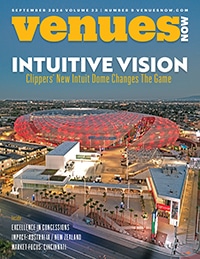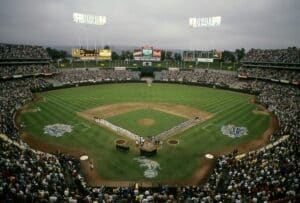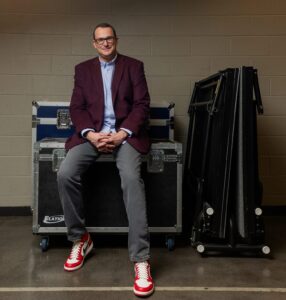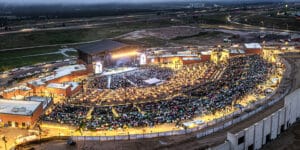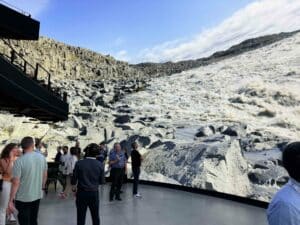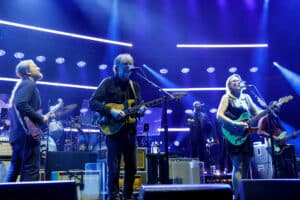BATTLE BY THE BAY: Oakland Coliseum was filled for the 1989 World Series between the A’s and Giants, shown here in an archival photo. The A’s final game in Oakland is Sept. 26. (Getty Images)
Oakland pitching great Dave Stewart among speakers
Andy Dolich isn’t letting the Oakland A’s sad departure to Las Vegas occur without issuing a dissertation on the 56-year history of the Bay Area team.
Dolich, who served as the A’s vice president of business operations from 1981-94, a stretch in which the MLB team made three consecutive World Series appearances and averaged 2.5 million in attendance over multiple seasons, is teaching a course on the woebegone franchise this fall as part of Stanford University’s continuing education curriculum.
“Winning and Wanderlust: The History of the Oakland Athletics,” the title of the online course, runs on Tuesday nights over six weeks from Oct. 22 to Dec. 3. Tuition is $405 with a refund deadline of Oct. 24.
As of Tuesday (Aug. 19), the day registration started, 20 people had signed up for the class, Dolich said, which is the minimum number required by Stanford to conduct the course.
Nobody’s more qualified than Dolich to document the A’s “complex identity,” as stated in the course description, and their fruitless pursuit of a new ballpark over the past 30 years. Class discussions will extend to Oakland Coliseum, the butt of jokes tied to the aging structure that opened in 1966, but a building that holds fond memories for Dolich and others, such as former A’s pitcher Dave Stewart, a member of the 1989 World Series championship squad.
Stewart, now leading a group effort to secure an MLB franchise in Nashville, is among the guest speakers Dolich has lined up for the course. Others are newspaper columnists Scott Ostler and Mark Purdy, ESPN’s Tim Keown, sports broadcaster Ted Robinson and Dave Newhouse, another columnist and co-author with Dolich of the book “Goodbye, Oakland: Winning, Wanderlust and a Sports Towns’ Fight for Survival.”
Dolich won’t deny that he’s promoting his book as part of the Stanford class, but it’s more than just collecting royalties, he said.
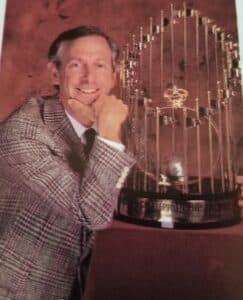
A’S RULE: Andy Dolich, shown here in 1989 with the World Series trophy after Oakland beat San Francisco. The series was marred by an earthquake prior to Game 3 at Candlestick Park. (Courtesy Andy Dolich)
The plan is to examine the good, bad and ugly revolving around the A’s legacy, plus the stories behind the departure of Oakland’s other two big league teams over the past five years, the Golden State Warriors and Las Vegas Raiders. Stewart will provide his perspective on his attempt to keep the A’s in town when he submitted a bid to acquire the city of Oakland’s 50% share of the coliseum for $115 million.
Three years ago, the city rebuffed Steward’s bid, ultimately favoring the African-American Sports and Entertainment Group, which paid $105 million for the city’s share. Earlier this month, the group agreed to purchase the A’s half-portion of coliseum property for $125 million, pending county approval. They intend to build a $5 billion mixed-use district on the 125-acre parcel.
“Dave and I have been friends for a long time since he was with the A’s,” Dolich said. “He’s a well-respected person in Oakland and can talk about the internal politics of that whole deal. He bid more money than (AASEG) and the city said no, which led him to shift his attention to Nashville.”
Purdy, who retired in 2017 after spending 33 years with the San Jose Mercury News, covered the A’s and their attempt at one time to relocate to San Jose. Across the bay, the San Francisco Giants killed that idea after invoking their territorial market rights, which covers that community about 50 miles south of San Francisco.
“There’s no one who speak about that issue better than Mark,” Dolich said.
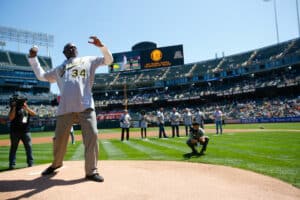
THROWING ‘SMOKE’: Former Oakland A’s pitcher Dave Stewart throws the ceremonial first pitch in 2019, celebrating the 30th anniversary of the A’s World Series title. Getty Images)
The A’s course will be the ninth class Dolich has instructed over the years after retiring from team sports that included executive positions with the San Francisco 49ers, Washington Capitals, Philadelphia 76ers and Memphis Grizzlies, where he was part of the initial front office when the NBA team moved from Vancouver, B.C. and opened FedEx Forum in Memphis in 2004.
He’s had up to 75 students in class over the years and one particular gentleman has been enrolled in all of them. People don’t have to be a Stanford student to take the A’s course. Dolich’s classes are typically a mix of younger people considering a career in sports business; those who love sports; and “lifelong learners” scanning Stanford’s catalog that decide to take the course as part of expanding their knowledge of history in general.
“It makes for a terrific mix of people, because they all have different perspectives, and that’s what I enjoy,” Dolich said.
One month before the course starts, Dolich and a group of his friends who worked for the A’s during their heyday 40 years ago will attend the team’s final home game on Sept. 26 at the coliseum. The A’s plan to play the next three seasons in Sacramento while their proposed $1.5 billion stadium is built in Vegas, although financing for the project has not been completed.
For older baseball fans, the A’s exit is bittersweet as well. They recall the “Swingin’ A’s” of the early 1970s, when Oakland won three consecutive World Series titles. No other MLB team has accomplished that feat over the past 50 years.
“For me and many others, it’s been gut wrenching,” said Dolich, who now lives in northern California wine country. “The Haas family (which owned the A’s from 1980-95) was the greatest ownership I’ve worked for in sports. We’ve bought a bunch of tickets and will get together to laugh and cry, pat each other on the back, show our World Series rings for those of us who were lucky to be there, and wave goodbye.”


